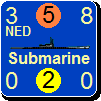Extraneous
Posts: 1810
Joined: 6/14/2008
Status: offline

|
quote:
And the Danes would have been mystified as to just what the heck the Norwegians were doing there.
_____________________________
Paul
September 12, 1941 ~ Coast Guard makes the first capture of WWII
The Greenland Patrol
In June and July 1941, the American naval forces congregating around Greenland were organized officially into the Greenland Patrol. The Northeast Greenland Patrol, with Iceberg Smith in command, consisted of the Cutter USCGC Northland (WPG-49), the wooden-hulled former survey ship Cutter USCGC North Star (WPG-59) and an old friend of the Coast Guard now flying a Navy pennant, the USS Bear (AG-29).
The Bear, a former seal catcher built in 1875 and used by the Revenue Cutter Service for years on the Bering Sea Patrol, now sported a modernized superstructure and an aircraft. The South Greenland Patrol, under LCDR Belcher of the Modoc, included the cutter Comanche, the Coast Guard icebreaking tug Raritan, and the Navy auxiliary schooner Bowdoin. In October, the two commands were consolidated under CDR Smith as the Greenland Patrol, designated Task Force 24.8 under the jurisdiction of the U.S. Atlantic Fleet.
A memorandum from ADM Harold Stark, the Chief of Naval Operations, outlined the mission of the Greenland Patrol:
"1. Naval operations will be required in Greenland ... for two purposes. The first purpose is to support the Army in ... establishing in Greenland airdrome facilities for use in ferrying aircraft to the British Isles.
2. The second purpose is to defend Greenland and specifically to prevent German operations in Northeast Greenland."
Iceberg Smith was, as Samuel Eliot Morison, the Navy's operational historian, put it after the war, being ordered "to do a little of everything - the Coast Guard is used to that."
The Army, on the basis of the information obtained by the South Greenland Survey, identified 13 sites, codenamed "BLUIE bases," that it thought could be turned into military installations. The most promising of these was located on a glacial moraine a few miles from the village of Narsarssuak.
In June 1941, a steady traffic of Army freighters and troop transports began steaming from Argentia, Newfoundland, to Narsarssuak, accompanied by Coast Guard cutters to protect them from U-boats and break up the storis (large drifts of ice) in their paths. By September, the Army engineers had constructed 85 buildings and three miles of access roads; the jeeps that were flown in were Greenland's first automobiles. Shortly a civilian contractor's force arrived to begin work on the airfield itself. BLUIE West 1 was to become the major U.S. Army, Navy and Coast Guard base in Greenland. Thousands of aircraft would stop there for refueling on their way to Britain.
< Message edited by Extraneous -- 1/8/2012 5:26:04 PM >
_____________________________
University of Science Music and Culture (USMC) class of 71 and 72 ~ Extraneous (AKA Mziln)
|
 Printable Version
Printable Version












 . Out of interest, why must Sheffield be the cruiser?
. Out of interest, why must Sheffield be the cruiser?

 If the USA was not at war it would be in Greenland involving Norwegians working for the Germans.
If the USA was not at war it would be in Greenland involving Norwegians working for the Germans. 
 New Messages
New Messages No New Messages
No New Messages Hot Topic w/ New Messages
Hot Topic w/ New Messages Hot Topic w/o New Messages
Hot Topic w/o New Messages Locked w/ New Messages
Locked w/ New Messages Locked w/o New Messages
Locked w/o New Messages Post New Thread
Post New Thread